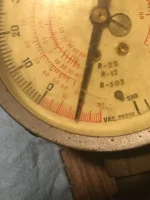Good Morning,
I had a big leak in my 91 Toyota. I decided to go haywire and replace every single O-ring in the 30 year old AC system. Amazingly, Toyota still had the original Oem R12 o-rings available for cheap.
For the compressor I bought an eBay reseal kit. I watched a YouTube video, how to reseal a Denso 10P compressor. It didn’t seem too difficult.
I have replaced all the seals on the compressor, including shaft seal.
Before putting everything back on the vehicle, is a vacuum test sufficient for a leak test? I don’t want to assemble the entire system again and find out it has a gaping leak.
I did a vacuum test on the compressor, and it did not leak overnight. It stayed right at -19psi for 12 hours.
Is a pressure test absolutely necessary? I studied nitrogen pressure tests, and they did seem more representative of an AC system than a vacuum test.
Anyone experienced with AC?
I had a big leak in my 91 Toyota. I decided to go haywire and replace every single O-ring in the 30 year old AC system. Amazingly, Toyota still had the original Oem R12 o-rings available for cheap.
For the compressor I bought an eBay reseal kit. I watched a YouTube video, how to reseal a Denso 10P compressor. It didn’t seem too difficult.
I have replaced all the seals on the compressor, including shaft seal.
Before putting everything back on the vehicle, is a vacuum test sufficient for a leak test? I don’t want to assemble the entire system again and find out it has a gaping leak.
I did a vacuum test on the compressor, and it did not leak overnight. It stayed right at -19psi for 12 hours.
Is a pressure test absolutely necessary? I studied nitrogen pressure tests, and they did seem more representative of an AC system than a vacuum test.
Anyone experienced with AC?

